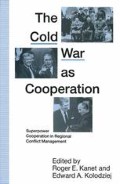Abstract
Northeast Asia is at the vortex of the Asia-Pacific Basin where four of the world’s five centers of power — the United States, the Soviet Union, China, and Japan — meet and interact. This is the only region in the world where such a mixture of two-power (superpower), three-power (strategic triangle), and four-power games are played out on multiple chessboards with all their complexities and configurations. Like great tectonic plates of the earth’s crust, any collision or collusion between and among the Big Four tends to restructure the alignment patterns not only of the region but globally as well. Northeast Asia also seems to be the only region where superpower conflict persists contrary to the more synchronized rhythms and the expanding virtuous circle of Soviet-American détente elsewhere.
I would like to thank Henry Bienen and William Feeney for their valuable comments and suggestions on an earlier version of the chapter. I wish also to acknowledge the support of much of the research and writing of this paper by the Peter B. Lewis Fund of the Center of International Studies, Princeton University.
Access this chapter
Tax calculation will be finalised at checkout
Purchases are for personal use only
Preview
Unable to display preview. Download preview PDF.
Notes
See Marc S. Gallichio, The Cold War Begins in Asia: American East Asian Policy and the Fall of the Japanese Empire (New York: Columbia University Press, 1988).
For detailed accounts of this and related events, see Soon Sung Cho, Korea in World Politics 1940–1950: An Evaluation of American Responsibility (Berkeley: University of California, 1967)
Gregory Henderson, ‘Korea’, in Gregory Henderson, Richard Ned Lebow, and John G. Stoessinger, Divided Nations in a Divided World (New York: David McKay, 1974), pp. 43–96.
Bruce Cumings, The Origins of the Korean War: Liberation and the Emergence of Separate Regimes, 1945–1947 (Princeton: Princeton University Press, 1981).
See Rober Gilpin, War and Change in World Politics (New York: Cambridge University Press, 1981)
Paul Kennedy, The Rise and Fall of the Great Powers: Economic Change and Military Conflict from 1500 to 2000 (New York: Random House, 1987).
Robert Gilpin, The Political Economy of International Relations (Princeton: Princeton University Press, 1987), pp. 328–36.
Samuel S. Kim, ‘Foreign Relations’, in John S. Major and Anthony J. Kane (eds), China Briefing, 1987 (Boulder, CO: Westview Press, 1987), pp. 69–97.
Mikhail G. Nossov, ‘The USSR and the Security of the Asia-Pacific Region: From Vladivostok to Krasnoyarsk’, Asian Survey, vol. 29, no. 3 (March 1989), p. 262
Charles E. Lindblom, The Intelligence of Democracy (New York: The Free Press, 1965), pp. 28–9.
For full discussion about various rules of the superpower game, see Alexander L. George et al., Managing US-Soviet Rivalry: Problems of Crisis Prevention (Boulder, CO: Westview Press, 1983).
As James Burnham put it: ‘At most, containment can be a temporary expedient, a transition. As the transition is completed, containment must move towards one or the other of the two major poles, towards appeasement or liberation.’ See James Burnham, Containment or Liberation? (New York: John Day, 1953, p. 31.
Franklyn Griffiths, ‘The Sources of American Conduct: Soviet Perspectives and Their Policy Implications’, International Security, vol. 9, no. 2 (Fall 1984), pp. 29–30.
Mikhail Gorbachev, Realities and Guarantees for a Secure World (Moscow: Novosti Press, 1987).
For partial text of this press conference statement, see Se-Jin Kim (ed.), Documents on Korean-American Relations 1943–1976 (Seoul: Research Center for Peace and Unification, 1976), p. 486
Samuel S. Kim, ‘United States Korean Policy and World Order’, Alternatives: A Journal of World Policy, vol. 6, no. 3 (Winter 1980–1), pp. 419–52.
Barry M. Blechman, Stephen S. Kaplan et al., Force Without War: US Armed Forces as a Political Instrument (Washington, DC: The Brookings Institute, 1978).
See Kenneth A. Oye, ‘International Systems Structure and American Foreign Policy’, in Kenneth A. Oye, Robert J. Lieber, and Donald Rothchild (eds), Eagle Defiant: United States Foreign Policy in the 1980s (Boston: Little, Brown, 1983), pp. 3–31.
See R. W. Johnson, Shootdown: The Verdict on KAL 007 (London: Chatto & Windus, 1986), p. 53
Alexander Dallin, Black Box: KAL 007 and the Superpowers (Berkeley: University of California Press, 1985), pp. 88–9.
Alexander George, ‘US-Soviet Global Rivalry: Norms of Competition’, Journal of Peace Research, vol. 23, no. 3 (1986), p. 249.
For further discussion on this problem, see Samuel S. Kim, ‘The United Nations, Lawmaking, and World Order’, Alternatives: A Journal of World Policy, vol. 10, no. 4 (1985) pp. 643–75.
Raymond L. Garthoff, Detente and Confrontation: American-Soviet Relations from Nixon to Reagan (Washington, DC: The Brookings Institution, 1985), p. 34.
Robert Legvold, ‘The Revolution in Soviet Foreign Policy’, Foreeign Affairs, vol. 68, no. 1 (1989), pp. 82–98.
See Samuel S. Kim, ‘Chinese World Policy in Transition’, World Policy Journal, vol. 1, no. 3 (Spring 1984), pp. 603–33
See Kent E. Calder, ‘Japanese Foreign Economic Policy Formation: Explaining the Reactive State’, World Politics, vol. 40, no. 4 (July 1988), pp. 517–41.
Charles E. Osgood, ‘Graduated Unilateral Initiatives for Peace’, in Quincy Wright, William M. Evans, and Morton Deutsch (eds), Preventing World War III: Some Proposals (New York: Simon and Schuster, 1962), pp. 161–77.
For the concept of ‘global learning’ and its ability in the study of foreign policy, see Samuel S. Kim, ‘Thinking Globally in Post-Mao China’, Journal of Peace Research, vol. 27, no. 2 (1990), pp. 191–209.
Editor information
Editors and Affiliations
Copyright information
© 1991 Roger E. Kanet and Edward A. Kolodziej
About this chapter
Cite this chapter
Kim, S.S. (1991). Superpower Cooperation in Northeast Asia. In: Kanet, R.E., Kolodziej, E.A. (eds) The Cold War as Cooperation. Palgrave Macmillan, London. https://doi.org/10.1007/978-1-349-11605-8_14
Download citation
DOI: https://doi.org/10.1007/978-1-349-11605-8_14
Publisher Name: Palgrave Macmillan, London
Print ISBN: 978-1-349-11607-2
Online ISBN: 978-1-349-11605-8
eBook Packages: Palgrave Political & Intern. Studies CollectionPolitical Science and International Studies (R0)

